How to choose an electric heated towel rail for the bathroom: selection tips and best options
A heated towel rail is a multifunctional bathroom accessory.It serves not only for drying towels, but also serves as a heater. A stylish model of modern design decorates the room and divides it into zones.
The devices differ in design, technical characteristics, and installation method. Let's look in detail at how to choose an electric heated towel rail for the bathroom and what parameters you should pay attention to.
The article is supplemented with information about the best manufacturers, whose products are in demand and have won positive customer reviews.
The content of the article:
A heated towel rail is an indispensable bathroom appliance.
An electric heated towel rail is a simple design made of a curved pipe and a heating element connected to a power source. Connection features depend on the design of the model. The device itself is attached to the wall or installed on the floor.
Most often, devices are purchased for bathrooms, but sometimes they are also appropriate in kitchens. The devices perform the functions of a towel dryer and warm up the air. Bathrooms are usually small, so such a modest radiator is enough to create a comfortable temperature.
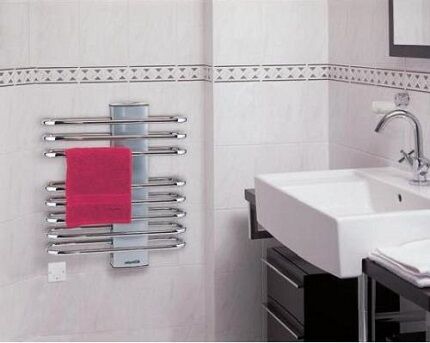
Regular heating of the bathroom prevents condensation and dampness. Thanks to this, the fungus multiplies less, which can completely ruin the finishing materials in a short time and even cause respiratory diseases among the residents of the house. Prevent education black mold easier than fighting it later.
A good heated towel rail is essential for any bathroom, especially in a home with small children. The main thing is to take into account all the features of the room and choose a device of suitable design and power.
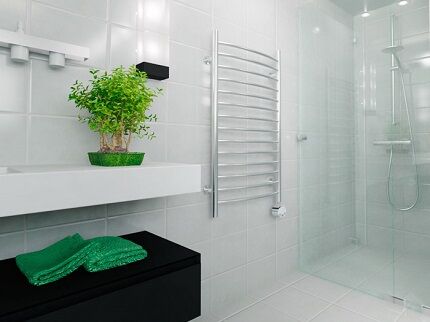
When is it better to use an electric model?
There are several types of heated towel rails - water, electric, combined. For a private house with autonomous heating and hot water systems, you can choose any option, but in an apartment with centralized heating, an electric or combined heated towel rail for the bathroom is more appropriate.
Water appliances are connected to the hot water system (imported ones are often designed for connection to heating). They are pipes through which hot water circulates.
In a private house, the owners themselves control the hot water supply, while apartment owners are deprived of this opportunity. They have water heated towel rails remain cold in the off-season, i.e. at a time when they are especially relevant.
It often happens that the temperature in the apartment is quite comfortable, but after a bath people feel chilly and may catch a cold.In such cases, it is impossible to do without an additional heating device in the bathroom.
An electric heated towel rail can be turned on exactly at the time when you really need it.
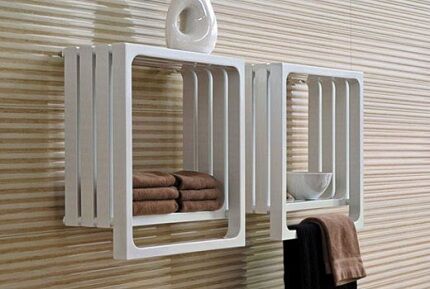
Advantages of electric coils
The list of arguments in favor of purchasing an electrical appliance includes:
- Economical. The devices consume a minimum of electricity, but their power is enough to warm up the bathroom. The disadvantages include the fact that heated towel rails still consume electricity.
- No leaks. Water models are subject to corrosion and sooner or later begin to leak. Nothing like this can happen with dry-type electrical devices.
- Wide design potential. Electric models are very diverse. There are stylish designer models that can become the main decoration of the bathroom.
- Independence from pressure in communication systems. The efficiency of water heated towel rails largely depends on pressure in the water supply system, sometimes they perform their functions worse due to air jams. Electric models do not have these disadvantages.
- Minimum emergency shutdown time. Power outages are a common occurrence in many areas, and this is a negative. However, there is a plus: if they happen, it is for a short time. Interruptions in hot water occur less frequently, but can last for weeks until repair or maintenance measures are completed.
Another significant advantage is the ability to easily change location.Moving a water device to another place is a labor-intensive task, because... the device is connected to the hot water supply or heating system.
To move an electric heated towel rail, it is enough to simply rearrange the fastenings. It takes just minutes.
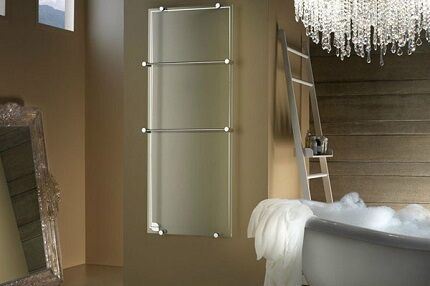
Electric heated towel rails are demanding in terms of installation location and power supply. Many breakdowns are associated precisely with non-compliance with the rules of connection and operation. Identify and fix a number of problems you can do it yourself.
Types of electric heated towel rails
There are “wet” and “dry” designs. In models of the first type, heating is carried out by a coolant (water, antifreeze or oil), which is heated by a heating element. According to the principle of operation, they are similar to electric heaters.
Differences in operating principle
Each type of coolant has its own advantages and disadvantages. Oil retains heat the longest after the power is turned off, but the maximum possible temperature of an oil heated towel rail is 70°C. The water warms up to 85°C, but cools down faster. Antifreeze has high thermal conductivity.
The advantages of “wet” appliances include the ability to retain heat after being disconnected from the network. The downside is that it consumes more electricity than “dry” heated towel rails. Another disadvantage is the shorter service life of heating elements, since they wear out faster in liquid.
Models with a “dry” heating element are more durable than their “wet” counterparts. On average, they last 3-5 years longer, although this largely depends on the quality of materials and assembly of the devices.
Devices of this type consume a minimum of electricity, and the range of models is more diverse, which expands the design possibilities of premises owners.
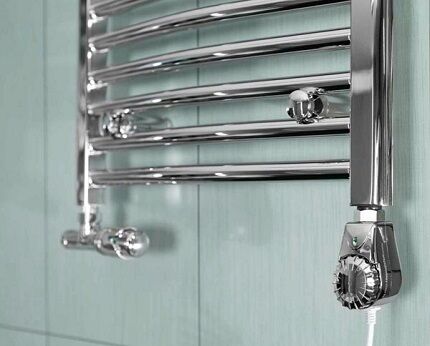
Execution form of different models
There are heated towel rails of various configurations, and designer models sometimes simply amaze with their elaborate design. But despite all the diversity, there are two traditional forms - snake and ladder.
Owners of devices have long been convinced that, despite their simplicity, both types of devices are practical. Which form should you prefer? Experts advise choosing a ladder.
There are several reasons for this:
- It is more convenient to place things to dry on the rungs of the heated towel rail-ladder: they do not slide off.
- Long items dry out faster because... heating is carried out along their entire length.
- The heating area of such a device is larger, which means the room will warm up better.
Snake-shaped heated towel rails have their advantages. They are cheaper because... Fewer materials are required to make them. In addition, such models are more compact and require less space for installation, which is important when there is a shortage of free space.
In many cases, it makes sense to buy a heated towel rail with sliding elements. When folded, it resembles a ladder, but the side parts can be moved to the sides and several things can be hung on them. Models with shelves are also convenient.
The final decision should be made after comparing prices, models and choosing a location for installation.

Wall and floor heated towel rails
Usually in bathrooms install wall-mounted heated towel rails, and for tight spaces this is the only correct solution, because... allows you to save space. But if the space allows, you can choose a floor-standing model, which has its own important advantages.
Floor-standing electric models appeared on the market relatively recently, but have already attracted the interest of many buyers. They are designs that combine the advantages of both heated towel rails and heaters. The devices are reliably protected from dampness and effectively heat the premises.
To install floor-standing models, you do not need to drill into the walls to mount the fasteners: you just need to place them in a convenient place and plug them into a power outlet. The devices are equipped with stable legs, so they do not tip over. If necessary, the heated towel rail can be easily moved to another location.
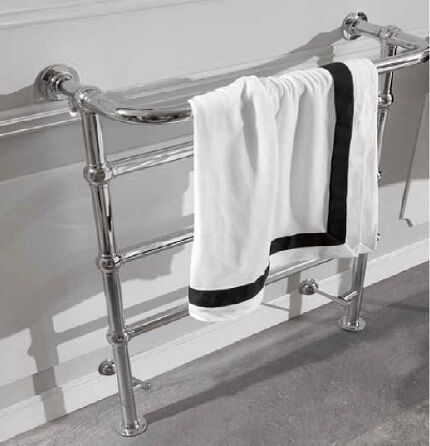
Which material should you prefer?
For the manufacture of electric heated towel rails, ferrous, stainless steel and non-ferrous metals are used. The cheapest models are made of black steel.
On the outside, the devices are almost no different from stainless steel products, and the internal surfaces of the tubes are coated with an anti-corrosion compound. Despite the treatment, black steel deteriorates quite quickly, and this is a big disadvantage.
Stainless steel models are universal and suitable for almost any bathroom.Painted heated towel rails are cheaper than chrome ones, but they also lose their presentable appearance faster. When purchasing a stainless steel device, you should take into account the “capriciousness” of their threaded connections. It is better to have such a heated towel rail installed by a specialist.
Designer models are often made of aluminum, copper or brass. Brass heated towel rails are extremely beautiful, have good heat transfer properties, but are rarely durable.
Copper models are almost flawless, but they are several times more expensive than devices made from other materials.
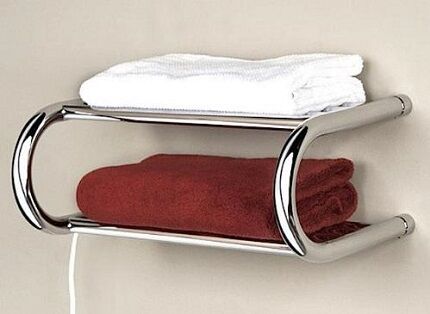
Guidelines for wise choice
To the list of characteristics that you should focus on when choosing a heated towel rail include:
- Design and installation method. Typically, bathrooms are not large in size, and a large number of plumbing fixtures and furniture have to be placed in them, so design is an important selection criterion. Even before purchasing a device, you should think about where it will be installed and how it will fit into the interior of the room.
- Power. It is necessary to calculate this figure so that for each square meter of the bathroom there is 150-200 W of power. When installing less powerful models, the room will be damp, and a device that is too powerful is more expensive and wastes energy.
- Method of connecting the device to the network. Heated towel rails are connected in open and hidden ways. When the connection is open, the wires from the appliance to the electrical outlet run along the surface of the wall. When hidden, they are disguised under the finishing.The first connection method is much simpler, and the second is safer.
- Economical. The power consumption of different types of appliances can vary significantly. Heating elements with a power of 100-2000 W are installed in heated towel rails. Powerful devices are often equipped with sensors and automation that turns them off when the set temperature is reached. This allows you to use energy resources more economically.
- Heating element type. Typically, the power of devices with “dry” and “wet” heating elements is the same, and the difference is only in the speed of heating and cooling. Most often, these are not fundamental indicators, but they are worth taking into account.
- Additional functions. Some models have timers, thermostats and other useful features.
We recommend paying attention to models with additional functions. Usually their cost is higher than that of “simple” heated towel rails, but such expenses pay off.
For example, people who shower before starting work often set a timer half an hour before waking up so that the bathroom is warmed up to a comfortable temperature in advance.

A thermostat in a heated towel rail can be very useful for families with small children. The device maintains a constant temperature, so you can wash or bathe your baby at any time in a warm bathroom and dry it with a dry towel, while energy consumption is extremely efficient.
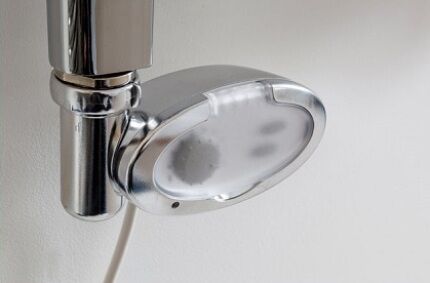
The best Russian and foreign manufacturers
The heated towel rail market is diverse: you can find models of any quality, design, price, so you should pay special attention to the brand and reputation of the manufacturer. Let's consider which electric heated towel rails our compatriots consider the best.
Italian company Margaroli produces models with power from 100 to 300 W. All of them are distinguished by a thoughtful design and increased comfort in operation.
Best manufacturers:
- Kermi. Kermi heated towel rails are truly German quality and Swiss reliability. The Kermi brand has been known on the market for more than half a century and is already considered legendary. The main advantage of this brand’s equipment is its reasonable price-quality ratio. Heated towel rails are made of good steel, mainly in the shape of a ladder. They are durable, reliable, and stylistically neutral.
- Arbonia. Designer radiators and heated towel rails from the Swiss company Arbonia are an expensive pleasure, but the quality and appearance of the products are beyond praise. Models are made of steel. Antifreeze is used as a coolant for combined heated towel rails. It is possible to manually adjust the heating temperature.
- Margaroli. Italian appliances from the Margaroli brand are not affordable for everyone. Heated towel rails of this brand are made of high-quality expensive materials and equipped with automatic equipment. There are devices made of brass. Distinctive features of Margaroli equipment are exquisite design and durability. The manufacturer is so confident in the quality of the product that it provides a 15-year guarantee.
- Energy. Energy Group is one of the leaders in the European heating equipment market.The manufacturer produces durable, high-quality devices. Any design: the range includes flat, three-dimensional, rotary models of various configurations. The Energy U G3K heated towel rail is especially popular because... combines good technical characteristics and reasonable price.
- "Sunerja". The Russian company produces elite models of heated towel rails, which are in demand not only in the domestic but also in the European market. The models are varied in design, made of stainless steel with a durable shiny coating. The warranty for Sunerge products is 5 years.
- "Dvin". The Russian company Dvin has produced more than 30 series of heated towel rails made of polished stainless steel. Most of the models are made in the form of a ladder. The manufacturer provides a 1 year warranty on its products.
- "Nika". Electric heated towel rails of the Nika brand have been known on the market for more than 10 years. Buyers value branded products for their good quality and stylish design. The company does not produce rotating models, but there are many interesting heated towel rails with shelves. The warranty on this company's products is 5 years.
- Terminus. The main advantage of heated towel rails of the Russian brand Terminus is a wide selection of models. Among them there are both budget and expensive ones. The heated towel rails are made of 2 mm thick steel. The models are distinguished by high performance characteristics and stylish design. The manufacturer provides a 10-year warranty.
- "Leader-Steel". Many buyers prefer the products of the Leader-Steel company. The heated towel rails are made of stainless steel, the heating temperature can be adjusted from 30 to 70 degrees. In case of overheating or hypothermia, the devices turn off automatically.The manufacturer provides a 5-year warranty.
- Terma. The Polish company Terma has been known on the market for more than a quarter of a century. During this time, it gained popularity among our compatriots.
Terma heated towel rails are made of high quality steel and equipped with thermostats.
A number of manufacturers produce, in addition to electric, water and combined models.
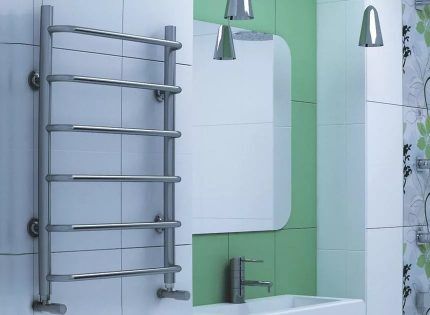
Conclusions and useful video on the topic
The design features and advantages of electric heated towel rails are discussed in the video below:
We offer a video that describes in detail the pros and cons of different types of heated towel rails:
Review of devices from the Sunerzha brand:
The choice of heated towel rail depends on the priorities and personal preferences of the buyer. The main thing is to pay attention to the quality of the product and carefully read the technical documentation.
If the model is chosen correctly, there will be no problems with it, because installation of the devices is elementary, and the heated towel rails themselves are very easy to use. If difficulties still arise, you can consult with specialists.
Looking for a practical electric heated towel rail? Or do you have experience using such installations? Please leave comments on the article and share your impressions of using heated towel rails.




It seems to me that electric heated towel rails were invented by designers, not engineers. Their main advantage is the variety of shapes and options for their location in the bathroom. And another plus is the possibility of autonomous use, even if the heating is turned off.I don’t think that this significantly increases electricity consumption due to the electrical appliance being constantly connected to the network. When choosing, I would pay more attention not to consumption limits, but to reliability, if it can somehow be determined from the parameters given by manufacturers.
How lucky I am to have you! The problem has been going on for some time: due to a leak, the old water heated towel rail was removed and an ordinary pipe was laid from floor to ceiling (I live in a high-rise building). Installing a new similar device is very expensive: both for it and for the work. And if you buy an electric one, and even a floor-standing one, it will cost, if not cheaper, then certainly without any hassle.
Those who believe that the energy consumption for operating a heated towel rail is not significant are mistaken. 200W*24h*30days = 144 kW*h per month. Of course, to some this is nonsense. I don't. But you still need a heated towel rail. And it’s rightly said: reliability is important. And further. I read the reviews. People often think about price, convenience, and design. People!!! Think about safety first! Imagine yourself or a child holding on to a heated towel rail (and any electrical appliance in the bathroom and not only) with a hand clenched from the electric current. You won’t be able to open your hand (by the way, sometimes people think that tile is an insulator. They are wrong). Imagine and try to take all measures to prevent this from happening.
What then is the RCD for?
First they write that it consumes no more than an electric light bulb, and then they say that the required power is 200 W per square area, i.e. 500-600 W for a small bathroom. This is not engineering-en.techinfus.com, but advice from an idiot.
A normal 500-watt light bulb =D In general, electric heating has always been the most expensive. A more economical water heated towel rail has not yet been invented, and an electric one should be installed only if there are no options to connect a water one.
For a small bathroom, a power of 290-390 W is sufficient (at the rate of 150-200 W per 1 sq.m).
I bought an electric heated towel rail "Bohemia-8" with a thermostat - after three months, the average consumption is 200 rubles per month. The thermostat automatically turns off, maintaining the temperature at the desired level - therefore energy saving.
It was very important for me not to run into a Chinese one, since my friends bought one, and less than a year had passed before it had to be replaced - it was all rusty and even began to drip in one place. I read reviews on the Internet and ordered myself from our Ukrainian manufacturer. I’m very pleased, there are no problems. It heats the bathroom efficiently, despite the fact that my bathroom is far from small in size.
I have an electric heated towel rail at home, it consumes 60 W. The room became significantly warmer. Bathroom size 1.7x1.7m.
The author has never seen heated towel rails from 35-60 watts? Let him Google it.
I have a double-circuit gas boiler in my house; in the summer, to heat the bathroom, I have to turn on the entire heating system. Therefore, an electric heated towel rail in the bathroom is simply necessary. It's good to have a choice!
The most important topic has not been touched upon - two types of heated towel rails: wet and dry. Or radiator and cable type, in other words. It is the second one that consumes 50-100.B (the first one can consume several kW) and if you don’t need to heat the bathroom, then you should install it.